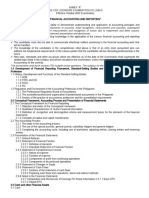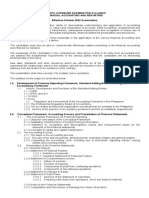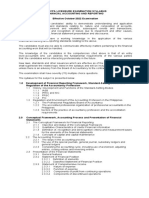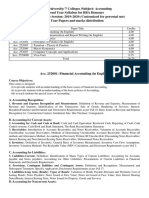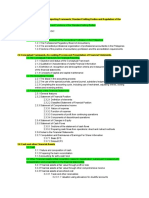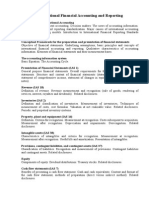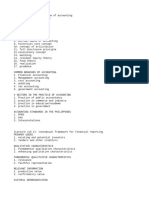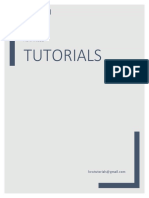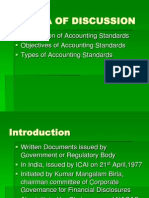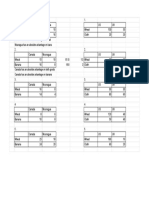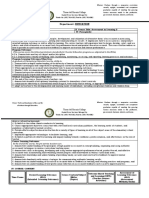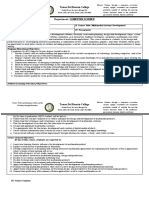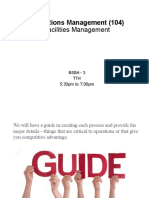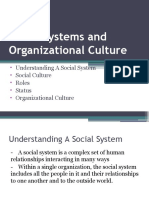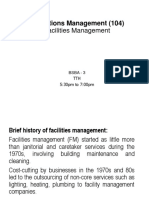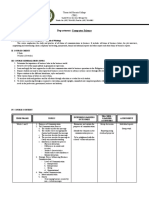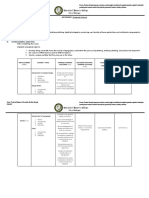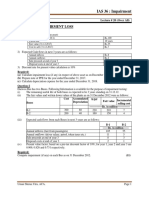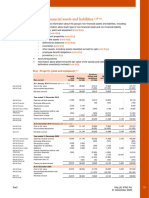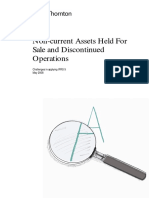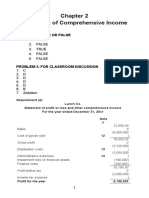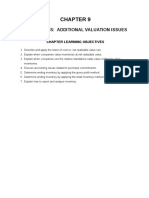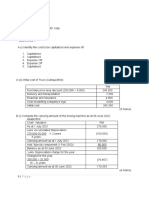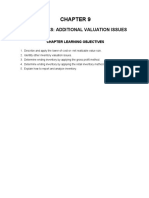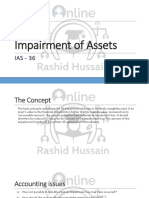Tomas Del Rosario College
Capitol Drive, San Jose, Balanga City, Bataan
Telefax No.: (047)791-6152; Tel. Nos.: (047) 237-3511, 237-0841
BACHELOR OF SCIENCE IN ACCOUNTANCY
(Course Syllabus)
Course: Actg. 3
Course Title: Financial Accounting & Reporting, Part I
Course Credit: Six (6) units
Prerequisite: Fundamentals of Accounting, Part II
Course Description
This course introduces the nature, functions, scope, and limitations of the broad field of accounting
theory. It deals with the study of the theoretical accounting framework objectives of financial
statements, accounting conventions, and generally accepted accounting principles, standard setting
process for accounting practice, national as well as international principles relating to the preparation
and presentation of financial statements, the conditions under which they may be appropriately applied,
their impact or effect on the financial statements; and the criticisms commonly leveled against them. The
course covers the detailed discussion, appreciation, and application of accounting principles covering the
assets, financial and nonfinancial. Emphasis is given on the interpretation and application of theories of
accounting in relation to cash, temporary investments, receivables, inventories, prepayments, long-term
investments, property, plant and equipment, intangibles, and other assets, including financial statement
presentation and disclosure requirements. The related internal control, ethical issues, and management of
assets are also covered. Exposure to computerized system in receivables, inventory, and lapsing
schedules is a requirement in this course.
Course Outline:
1. Concepts and principles relating to the preparation and presentation of financial statements
2. Financial Reporting Standards Council and Conceptual Framework for the Preparation and
Presentation of Financial statements
2.1 Financial Reporting Standards Council (Creation, objectives and functions;
Membership/composition; Standard setting process)
2.2 The IASB, history, current structure and processes, globalization of capital markets, calls
for the harmonization of accounting standards, formation and achievements of the IASC
2.3 Conceptual Framework for the Preparation and Presentation of Financial Statements
2.3.1 Users and their information needs
2.3.2 Objective of financial statements
2.3.3 Underlying assumptions in the preparation of financial statements
2.3.4 Qualitative characteristics of financial statements (Understandability,
Relevance, Reliability, Comparability)
2.3.5 Principles of Recognition and Measurement (Measurement base)
2.3.6 Elements of financial statements and their definition (Assets, Liabilities,
Equity, Income, Expenses)
� 2.3.7 Recognition and measurement of the elements of financial statements
2.3.8 Concepts of capital and capital maintenance (Financial concept, Physical
concept)
3. Introduction to Financial Instruments
3.1 Definition of financial instruments [Financial assets: nature and examples, Financial
liabilities: nature and examples, Equity instruments: nature and examples (Distinction
between equity and financial liabilities), Compound financial instruments]
3.2 Categories of financial assets/financial liabilities
3.3 Financial assets covered by PAS 32 & 39
3.4 Other financial assets excluded from the scope of PAS 39 and addressed under other
PFRS
3.5 Approach in accounting for financial instruments
3.6 Nonfinancial assets/nonfinancial liabilities: nature and examples
4. Accounting for Cash
4.1 Definition, nature and composition of cash and cash equivalents
4.2 Recognition and measurement of cash
4.3 Management and control of cash (Accounting of petty cash fund, Bank reconciliation at a
single date)
4.4 Financial statement valuation, presentation and disclosure
5. Accounting for Receivables
5.1 Definition, nature and classification of receivables
5.2 Accounting for receivables [Recognition, Initial and subsequent measurement,
Impairment and uncollectibility of receivables (Assessment and recording of impairment
loss, Reversal or recovery of impairment loss), Derecognition, Generating cash from
receivables]
5.3 Accounting for notes/loans receivable (Definition and types of promissory notes,
Recognition, Initial measurement and valuation at present value)
5.4 Receivable financing arrangements {Accounts receivable [Pledging (general assignment
of receivables), Factoring, Assignment of specific receivable]; Notes receivable
(Discounting)}
5.5 Notes/loans receivable impairment and uncollectibility
5.6 Financial statement presentation and disclosure
5.7 Internal control measures for receivable
6. Accounting for Investments in Equity and Debt Instruments including basic concepts on
Derivatives (covered by PAS 32 and 39)
6.1 Investment in equity instruments covered by PAS 32 and 39 [Investment in marketable
equity securities (Designated at fair value through profit or loss, Trading, Available-for-
sale), Investment in unquoted equity securities]
6.2 Investment in debt instruments [Held-to-maturity investments, Not held-to-maturity
(Trading, Available-for-sale)]
7. Accounting for Inventories
7.1 Definition, nature and classes of inventories
7.2 Recognition
7.3 Initial measurement at cost
� 7.4 Inventory recording systems (Periodic inventory system, Perpetual inventory system)
7.5 Inventory costing methods (Items not ordinarily interchangeable: Specific identification;
For items that are interchangeable: First in, First out, method, Weighted average cost
method)
7.6 Inventory estimation methods [Gross profit method, Retail inventory method (excluding
peso value and retail info)]
7.7 Valuation at lower of cost and net realizable value (Write-down to net realizable value,
Reversal of write-down)
7.8 Other Inventory Issues (Purchase commitment, Inventory valued at selling price, Use of
more than one cost method, Borrowing costs, Lump-sum acquisition, Inventory errors)
7.9 Financial statement presentation and disclosures
7.10 Internal control and management of inventory
8. Accounting for agricultural activities and biological assets
8.1 Definition, nature and classes
8.2 Recognition
8.3 Initial measurement at cost
8.4 Valuation at lower of cost and net realizable value (Write-down to net realizable value,
Reversal of write-down)
8.5 Financial statement presentation and disclosures
9. Accounting for Property, Plant and Equipment
9.1 Definition, nature and classes
9.2 Recognition
9.3 Initial measurement (Cash purchase, Purchase on a deferred payment contract, Issuance
of securities, Donation or discovery, Self-construction, Exchanges of non-monetary and
monetary assets)
9.4 Expenditures subsequent to acquisition
9.5 Valuation or measurement subsequent to initial recognition (Benchmark method – cost
less accumulated depreciation and accumulated impairement losses; Allowed alternative
method – revaluation at fair value less) accumulated depreciation and accumulated
impairment losses
9.6 Depreciation of assets (Definition, nature and causes; Factors affecting depreciation;
Methods of depreciation (Straight-line method, Declining balance method, Sum-of-the-
years’ digits method, Group and composite depreciation)
9.7 Depletion of wasting assets
9.8 Accounting changes affecting depreciation
9.9 Revaluation of property, plant and equipment (Recording on date of revaluation,
Frequency of revaluation, Revaluation increase, Revaluation decrease, Realized
Revaluation)
9.10 Impairment of assets (Definition, When to recognize and how to measure impairment
loss, Measurement of recoverable amount, Impairment loss for an individual asset,
Impairment loss for cash-generating unit, Reversal of previously recognized impairment
loss)
9.11 Retirement and disposals
9.12 Financial statement presentation and disclosures
9.13 Internal control and management of property, plant and equipment
�10. Accounting for Intangible Assets
10.1 Definition, nature, and classes
10.2 Recognition criteria
10.3 Initial measurement and accounting for intangibles (Patents, Copyright, Trademarks and
trade names, Franchise rights, Leaserights, Computer software, Goodwill, Research and
development costs, Other intangible assets)
10.4 Subsequently incurred costs
10.5 Measurement subsequent to initial recognition (Cost method, Revaluation method)
10.6 Amortization
10.7 Impairment of value of intangible assets
10.8 Reversal of impairment loss
10.9 Retirements and disposition
10.10 Financial statement presentation and disclosures
10.11 Internal control measures for intangibles
11. Accounting for Other Types of Investments
11.1 Investment in cash surrender value of life insurance
11.2 Investment in funds/Bonds
11.3 Investment property
11.4 Investment in associates*
12. Accounting for Noncurrent Assets Held for Sale
Detailed discussion covered in Advanced Accounting subjects
Suggested References
Alfredson, Keith, L. Ken, R. Picker, P. Pacter, and J. Radford. (2005). Applying International
Accounting Standards. Australia: John Wiley and Sons, Ltd.
Cabrera, E. B. Financial Accounting and Reporting, Theory and Practice Volume 1, 2007
Edition, GIC Enterprises, C. M. Recto, Manila
Robles, N., and P. M. Empleo. (2005). Intermediate Accounting Volume 1 (2005).
Mandaluyong: Millenium Books, Inc.
Valix, C. T. and J. Peralta. (2007). Financial Accounting Volume 1 (Based on PAS, PFRS, IAS,
IFRS). Manila: GIC Enterprises.
Valencia, E. and G. Roxas (2004). Financial Accounting. Mandaluyong Millennium Books, Inc.
Baysa, Gloria T., MC. Y. Lupisan, and E. F. Ledesma. (2006). Financial Accounting Theory.
Mandaluyong Millennium Books, Inc.
Padilla, N. (2005). Financial Accounting – Theory of Accounts. Manila: GIC Enterprises.
Weygandt, Kieso, and Warfield, Intermediate Accounting (2004) 11th Ed., Millennium Books,
Inc., Shaw Blvd., Mandaluyong City.
Compilation of Philippine Accounting Standards (PAS), Philippine Financial Reporting
Standards (PFRS)

